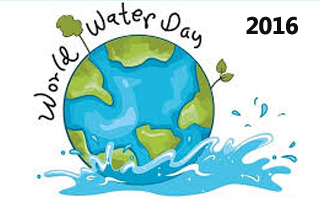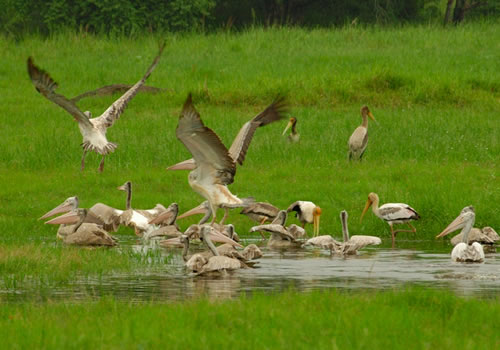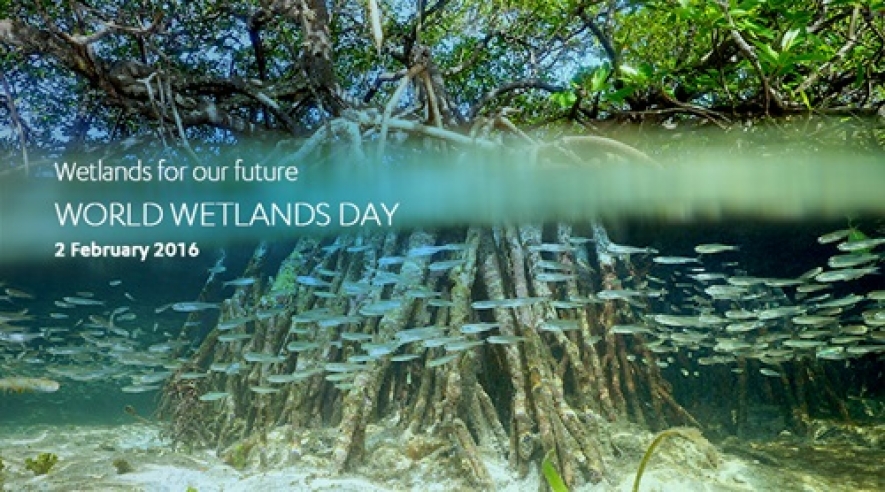 Wetlands for our Future: Sustainable Livelihoods is the theme for World Wetlands Day in 2016. This theme is selected to demonstrate the vital role of wetlands for the future of humanity and specifically their relevance towards achieving the new Sustainable Development Goals.
Wetlands for our Future: Sustainable Livelihoods is the theme for World Wetlands Day in 2016. This theme is selected to demonstrate the vital role of wetlands for the future of humanity and specifically their relevance towards achieving the new Sustainable Development Goals.
Wetlands in Sri Lanka
Introduction
In the past, wetlands were considered as wastelands that could be reclaimed or changed for use by mankind. Development initiatives have regarded these areas suited only for such purposes, and as a consequence, many wetlands have been drained or used as dump sites for refuse and urban waste. With increasing knowledge however, we have come to understand that wetlands are amongst the world's most valuable and vulnerable environments on which a variety of plants, animals and human communities depend. Initially, interest in wetlands centred on naturalists and waterfowl hunters, but today, a growing section of society has become aware of the benefits to be accrued from both marine and freshwater wetlands. Gradually, it is being recognized that, by using and maintaining wetlands in a sensible way, other sectors, such as agriculture, flood control, water purification, fisheries and recreation could be significantly improved. In Sri Lanka, the conservation of wetlands has been vested mostly with the wildlife sector as reflected by the Fauna and Flora Protection Ordinance of 1938 and its amendments. However, for a number of reasons due recognition for the importance of conserving wetlands in the country has not effectively come off the ground until recently.
What are wetlands?
 Wetlands are simply habitats with permanent or temporary accumulation of water with associated floral and faunal communities. Interest in wetlands initially revolved around exploitation of the associated natural resources, mainly through waterfowl hunting. These interests resulted in the Convention on Wetlands,referred to as the Ramsar Convention – an intergovernmental framework for wetland conservation, being adopted in 1971. At this historic meeting held in Ramsar, Iran, a consensus evolved on a broad definition for wetlands. Designed to provide international protection to the widest possible group of wetland ecosystems, the Ramsar convention has defined wetlands as follows:
Wetlands are simply habitats with permanent or temporary accumulation of water with associated floral and faunal communities. Interest in wetlands initially revolved around exploitation of the associated natural resources, mainly through waterfowl hunting. These interests resulted in the Convention on Wetlands,referred to as the Ramsar Convention – an intergovernmental framework for wetland conservation, being adopted in 1971. At this historic meeting held in Ramsar, Iran, a consensus evolved on a broad definition for wetlands. Designed to provide international protection to the widest possible group of wetland ecosystems, the Ramsar convention has defined wetlands as follows:
"Areas of marsh, fen, peat land or water, whether natural or artificial, permanent or temporary with water that is static or flowing, fresh, brackish or salt, including areas of marine water the depth of which at low tide does not exceed six metres." The wetlands of Sri Lanka, which fit into the Ramsar definition, can be divided into three broad categories:
• Inland natural fresh water wetlands (e.g. rivers, stream, marshes, swamp forests andvillus)
• Marine and salt water wetlands (e.g. lagoons, estuaries, mangroves, sea grass beds, and coral reefs)
• Man-made wetlands (e.g. tanks, reservoirs, rice fields and salterns)
Threats of Wetlands in Sri Lnaka
A majority of the wetlands in Sri Lanka are facing various threats that are posed by harmful human activities. An analysis of the identified threats pertaining to the wetlands listed for Sri Lanka in the Directory of Asian Wetlands (Scott, 1989) brings out some very interesting information. The most frequently reported threat appears to be siltation. It should be realized that this is usually not caused by factors in the wetland itself but by actions on lands adjacent or away from the wetland. The development of aquaculture poses serious threats to wetlands. Since the white spot attack, the rate of conversion has changed to a situation where most ponds been abandoned, thus leaving many desolate areas. The future threat of conversion still looms due to the high price of shrimp. The present broad threats can be summarized under four major categories; habitat deterioration/ degradation, direct loss/exploitation of species, spread of invasive alien species and natural phenomena.
Conservation of Wetlands in Sri Lnaka
Interest in conservation of wetlands can be traced back in the recent history to the late nineteenth century. Around 1897, enactments to protect the coastal belt systems were promulgated. The Fauna and Flora Protection Ordinance of 1937 can be considered as a major step in wetland conservation. Using this legislation, wetlands of importance to birds have been declared by the Department of Wildlife Conservation as sanctuaries and other protected areas. The ordinance has also provided protection to fauna in the immediate limits of any water body.
Sri Lanka signed the RAMSAR Convention in 1971, but ratified it only in 1990. But interest in wetlands had remained high in the countries conservation agenda, as preliminary inventories of wetlands were produced in 1982 (Hoffmann 1982). In 1984, Sri Lanka hosted the regional meeting of the International Council of Bird Protection- Asian Continental Section. The main theme of the meeting was wetland conservation. As a gesture the government committed to ratify the Ramsar convention, but action was initiated in this regard only in 1990. The discussion laid the foundation for the preparation of the Asian Wetland Directory, which was published in 1989.
By 1986, the interests on wetlands picked up with four workshops held by the National Aquatic Resources Agency (NARA), Natural Resources, Energy and Science Authority (NARESA) and the Coast Conservation Department (CCD).Interest in the development of the Muthurajawela Marsh was a major activity which led to a comprehensive study of the marsh and the preparation of an ecological profile and a management plan. This was the first ever attempt to develop any wetland on the basis of "wise use" criteria. The report was published in 1992.
Since 1987, it was recognized that wetlands were falling under the responsibility of numerous agencies and as such the need to introduce coordination was recognized. Accordingly by 1989, an interim Wetland Steering Committee was established by the Central Environmental Authority. This action received Cabinet approval in 1990. Efforts to prepare a wetland Commission, legislation and policy were mooted through this Steering Committee. The Wetland Conservation Project of the Central Environmental Authority resulted in the preparation of numerous wetland site reports, management plans, guiding texts and the consolidation of the wetland division of the CEA. Concurrent strengthening of implementation agencies however did not go in parallel and thus there is a gap between planning and implementation of conservation actions.
Since the ratification of the Ramsar Convention in 1990 with the entry of Bundala (presently National Park), Sri Lanka has included and declared five other Ramsar wetland sites; the Anaiwilundawa ancient cascading tank system, the Maduganga estuary and mangrove ecosystem, Venkali Santuary , Kumana Wetland Cluster and Wilpattu Wetland Cluster. The National Wetland Policy which was published by the government in 2006 has highlighted the conservation of wetlands, and a need for an effective mechanism institutional mechanism to coordinate wetland conservation activities in the country.
A wetland management unit has been proposed in the policy to be established at the Central Environmental Authority for overall coordination of wetland activities in the country. At present, there are several government and non-government organizations involved in wetland conservation and management related activities in Sri Lanka. In addition, several researchers attached to national universities and private research institutions are involved in wetland related research activities.Amidst these conservation initiatives, majority of the inland freshwater wetlands in Sri Lanka are under threat due to adverse anthropogenic activities.
The present development activities that have been planned for economic growth of the country exert further pressure on existing wetlands, especially on marshes in low-lying urban/sub-urban areas. Therefore, the future sustenance of inland wetlands and their biological resources within the context of increasing allocation of wetland and water resources for a growing human population is a challenge that needs to be addressed wisely. Conservation biologists and environmentalists will have to work in close collaboration with development planners and policy makers, in order to find viable solutions to the above challenges that would play a decisive role in the future conservation of inland freshwater wetlands in Sri Lanka.




















